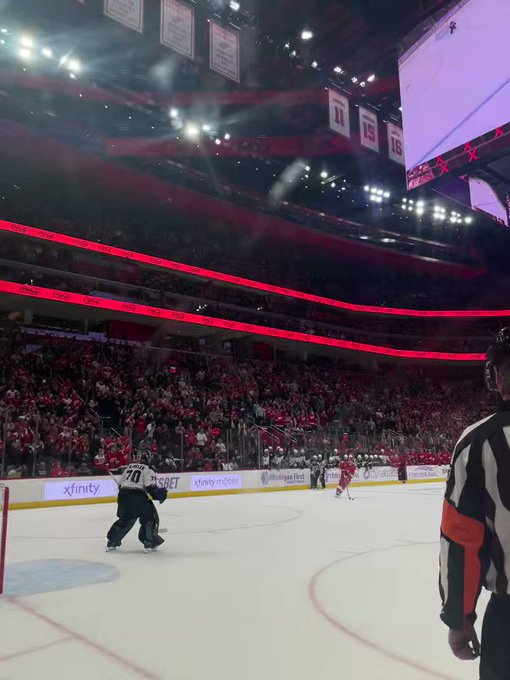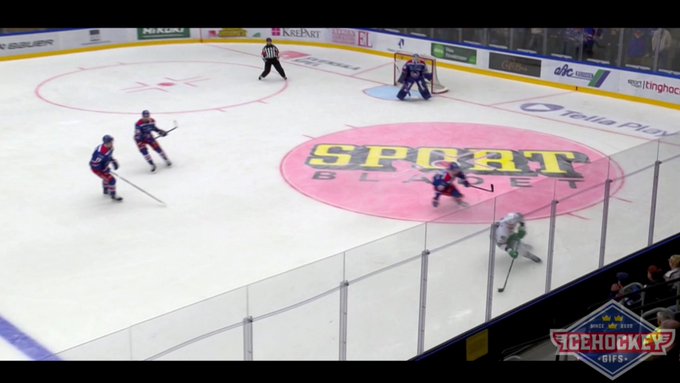While most of the talk around the Detroit Red Wings’ prospect pool revolves around the likes of defencemen (Moritz Seider, Simon Edvinsson, William Wallinder) and goalies (Sebastian Cossa), their best forward prospect is having himself a breakout season in the Swedish Hockey League (SHL).

Marco Kasper has 10 points in 19 SHL games this season. He has the production, tenacity, and skill to surpass both Joel Eriksson Ek (of Minnesota Wild fame) and Dylan Larkin to become a number-one center in the NHL.
Kasper’s Pre-Draft Year & Draft Year Production
A crucial point in development for a prospect is his pre-draft and draft year. Together they establish a pattern of progression and maturity. Those years for Kasper and Eriksson Ek look fairly similar.
In his pre-draft year (D-1), Eriksson-Ek collected four points in 13 J20-level games; a 0.30 points per game pace (PPG). Kasper managed to accrue two points in six J20 games – a 0.33 PPG. That’s a pretty similar point pace for these two players. Additionally, in their draft year J20 games, Eriksson-Ek accumulated 32 points in 25 games to Kasper’s 13 points in 12 games.
Comparing Larkin to Kasper requires looking at NHLe, because they played in different leagues. NHLe is a formula used to normalize scoring rates across the different leagues that prospects play in to help predict future NHL scoring rates. So if a prospect has an NHLe of 20, that means if they had played in the NHL that year instead of the league they were in, they would have scored 20 points.

There are several different models out there, all with slight variations. My preferred model is the one on the Hockey Prospecting website, but there is a free NHLe calculator on the Dobber Frozen Tools website as well.
Looking at Hockey Prospecting (pictured above) Kasper and Larkin have an NHLe of seven & 10 respectively in their D-1 season, and 20 and 24 in their draft year. Their draft plus one year (D+1) is shaping up to be very interesting. At this point Kasper is behind by eight NHLe of what Larkin produced in his D+1 year. With a good chunk of the season left to play, there’s a chance for Kasper to catch up or surpass Larkin’s equivalency.
Kasper Heating up the SHL
Kasper is presently in his draft plus one year (D+1), with very promising production. With 12 points in 20 games, his NHLe is sitting at 39. If he maintains this pace he will double his NHLe from his draft year which bodes well for the young Austrian pivot.

Eriksson-Ek only increased his NHLe by one in his D+1 (24). It’s a tough league to play in, so any improvement while jumping up in competition is notable for a prospect. However, it’s not the kind of jump that sets a player up to be elite. Conversely, Larkin saw an increase up to 47 NHLe. An increase of five or more is considered good. An increase over 20 is even better.
With almost half the season left, Kasper is trending closer to Larkin’s trajectory than Eriksson-Ek’s. A reason for excitement is Kasper is just starting to unearth some very high-end skills that will make him eventually rise above both Eriksson-Ek and Larkin.
Kasper’s Tenacity Is Unmatched
The biggest hallmark of Kasper’s game is his much-talked-about tenacity. He never gives up on plays, and always fights for the puck whether along the boards or in front of the net. A good place to find clips of his games is on various Twitter accounts; a great one of him can be found here.
Related: Red Wings’ Prospect Report Kasper & Wallinder Shining Early
Latest News & Highlights
Kasper starts the play above by body-checking the puck carrier and gaining possession. He makes a simple pass to a teammate heading to the net, and then begins fighting for open position in front of the goal with a couple of cross-checks for good measure. He approaches every game with this level of hard work and grit. There isn’t a play he’s involved in where he quits, he always puts it all out on the ice.
Kasper Has Skill for Days
Kasper’s puck skills are probably the most underrated part of his game. He has incredibly soft hands and can avoid pressure with deft stick-handling or assertive passing. He also has a great shot, which people don’t talk enough about. He scores a lot of his goals around the crease, where he puts up with abuse for the sake of giving his team an edge.

Often a “gritty” player who is skilled does not display the same level of skill at top speeds that he does at a slower pace. Kasper bucks that trend by being both gritty and highly skilled with the puck, and is able to use that skill to maintain possession in the offensive zone.
Eriksson-Ek and Larkin are very skilled players too. Here is a highlight reel goal by Eriksson Ek from the beginning of May last season starting at 0:29:
Eriksson-Ek and Kasper play a very similar game. They are both great at causing mischief in front of the opponent’s net, suffering abuse at the hands (and sticks) of defenders trying to give their goalies the best chance to make a save. They also display flashes of high-end skill and have great wrist shots.
Kasper is already displaying this level of skill before he’s even in the NHL. That’s incredibly promising for the young Austrian. Larkin has found a whole new gear in his game too, scoring some fantastic goals already this season:
This is a great game-winning shootout goal from Larkin. Kasper shows a similar level of skill here and an incredible wrist-shot goal here. Keep in mind with these clips that Kasper is playing in a league with adult competition, and not a junior league where you age out at 21 years old. His game is very translatable to the big leagues and he should have no problems being an effective NHL player in the future.
Kasper’s Michigan Attempt
At the moment of this posting, only Filip Forsberg, Andrei Svechnikov, and Trevor Zegras have scored a lacrosse-style goal or “Michigan”. Sidney Crosby, Auston Matthews, and Claude Giroux have also attempted to score Michigan’s and have been unsuccessful. All of these players have a PPG rate of 0.76 or above; Forsberg (0.83), Svechnikov (0.76), Zegras (0.77), Crosby (1.27), Matthews (1.12), and Giroux (0.91). Do you need to have a PPG of 0.76 to score a Michigan? No, but clearly the players that do score on (or attempt) this move produce at a high level and have the high-end skill to score these kinds of goals. Larkin sits at 0.73 PPG and has not scored or attempted this kind of highly skilled play.
Looking at Kasper’s attempt, he receives a pass from behind, taps it between his legs to his left skate, receives the puck on his backhand in front of himself, and then effortlessly attempts a Michigan goal. He doesn’t score, but collects the puck and gets a primary assist on his teammate’s goal.
With his combination of production, gritty play, and elite skill, Kasper is poised to become a number-one center in the NHL, ahead of the likes of Eriksson-Ek and Larkin (to name a few). His floor is Eriksson-Ek but his ceiling is beyond Larkin. As such, his incredible combination of tenacity and elite puck skills should eventually elevate him to dethrone Larkin as the top center for the Red Wings.
Caleb has loved watching hockey for as long as he could eat a bowl of ice cream. Over decades this love grew into participating in Fantasy Hockey, first in redraft leagues and eventually Dynasty leagues.
Caleb is presently Lead Scout for the Fantasy Hockey Life podcast. Additionally he writes bi-weekly and monthly articles for Dobber Prospects as well as covering Columbus Blue Jackets prospects for Dobber. At The Hockey Writers he covers the Detroit Red Wings.





